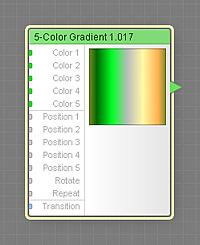
This component is obsolete and its use in filters is not recommended. Use the recent version of the component.
The 5-Color Gradient component produces a gradient defined by five colors and their positions. This is a map component, it can be located in the Gradients category on the Components Bar. 5-Color Gradient is a discrete component: any filter that uses it is automatically classed as a discrete filter.
Color 1, 2, 3, 4, and 5: Map Inputs
These parameters specify the five colors of the gradient. The positions of these colors within the gradient are determined by the corresponding parameters Position 1, 2, 3, 4 and 5. When a map component is connected to any of these inputs, its output is 'seen through' the area of the corresponding color.
These parameters specify the position of each color within the gradient. Position 1 defines the position of Color 1, Position 2 of Color 2, etc. The values range from 0 to 100 and are measured as percentages of the global parameter Size. For example, if Size is 600 pixels and Position 1 is 10, the first color will be positioned at the 60th pixel from the image border.
Specifies the direction of the gradient. When Rotate is set to 0, the gradient is oriented horizontally, with the colors arranged from left to right. Rotate of 90 rotates the gradient by 90 degrees clockwise, so that the colors are arranged vertically, from top to bottom. Rotate of 180 rotates the gradient by 180 degrees clockwise, relative to the position of Rotate of 0. Rotate of 270 rotates the gradient by 270 degrees clockwise, relative to the position of Rotate of 0.
Specifies how many times the gradient is repeated. The actual number of repetitions within the output image is also affected by the global parameter Size and the image dimensions (width or height, depending on the Rotate parameter). For example, when Repeat is 3, Size is 600 pixels and the image width is 1200 pixels, the pattern will be repeated 6 times within the image width.
Transition: Curve Input
Determines the transition between the colors of the gradient. Four predefined transitions are available: Linear, Smooth, Bands, Waves. To customize the transition, connect a curve component to this input.
In order to produce a smooth transition, the curve connected to the Transition input must start at 0 and end at 100% – curves like Linear, Step, Gain and Stairs are perfect choices, while curves like Noise or Wave will require additional adjustments or modifications (for example, you can use the Fade component to force the start and end of any curve into desired positions).